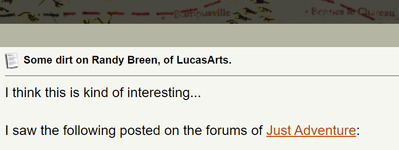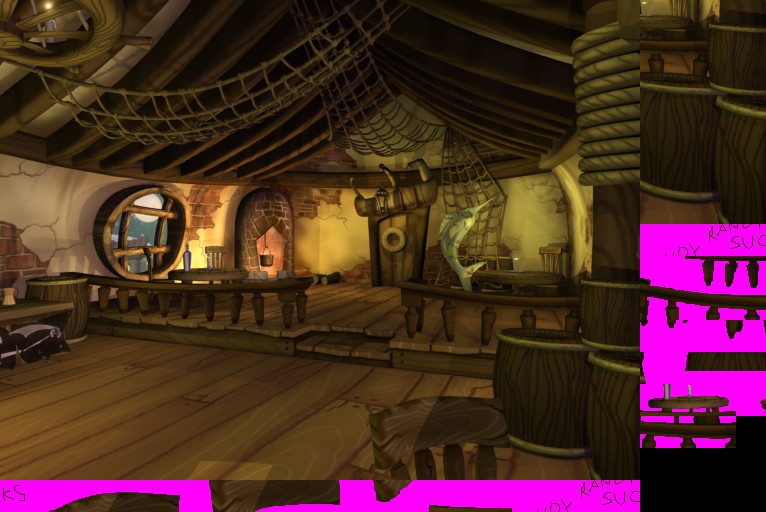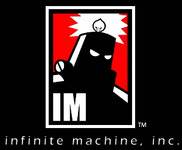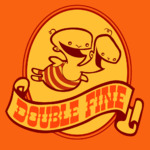Part 2: Brain Drain
Externally, the consequence of monogamous devotion to one fertile movie property was pretty obvious once the curtain came down on the 90s: a non-Star Wars game from LucasArts had now reached near-Bigfoot levels of elusiveness. (That I am resorting to defining “original title” as “a non-Star Wars title” for the purposes of this article is commentary unto itself.) The following may sound like an exaggerated statistic, but you can look it up for yourself: between 1998 and 2002, with the exception of Grim Fandango, Indiana Jones and the Infernal Machine, and the fourth Monkey Island, literally every title that LucasArts put out was a Star Wars game. It kind of says it all; it speaks louder than any number of griping paragraphs would. Although Mixnmojo, in those days at its most vivacious, certainly did its fair share of wailing.

What’s been less examined are the internal consequences. Just as its long-term fans were naturally disappointed that the studio that built its brand on a library of truly unique experiences was now enthusiastically recasting itself as, in effect, an opportunistic merchandising tentacle of a phenomenally popular film franchise, the monotony wasn’t exactly a thrill for a lot of the developers, either. Imagine pursuing LucasArts as a dream job based on what you had grown up watching them put out in the late 80s and early 90s, only to find yourself painting textures for Yet Another Pod Racer.
The veterans would have had even more reason for disillusionment, and there was indeed a mass exodus of (pointedly, non-Star Wars for the most part) heavy-hitters during this period: Tim Schafer, Jonathan Ackley, Larry Ahern, Bill Tiller, Aric Wilmunder, Chuck Jordan, and Justin Chin to name a few.
Infinite Machine (Chin) Double Fine (Schafer), Autumn Moon (Tiller), Crackpot (Ahern and Mike Levine) were some of the new companies founded by those who flew the coop during this period.
On an individual basis, these departures are not eyebrow raising, as folks who have been under one roof for a while will naturally be ready to move on (as Ron Gilbert and Dave Grossman had years earlier), but taken in aggregate it transmits a signal. And such home-grown talent, once lost, is not easily replaced, especially with the Gold Guy meaning a little bit less than he did once before, and thus representing a decidedly dimmer lighthouse for beckoning the best and the brightest with.
Speaking to GameSpy in 2005 during his promotional tour for Psychonauts, Tim Schafer spoke of this with the insight of a first-hand witness:
But then LucasArts moved on to create Star Wars games, and the first ones were incredible. The team poured all the creativity and talent they had into the licensed products. And they made a lot of money. But gradually, in Schafer's eyes, a subtle shift began to happen. Resources gradually migrated from original game ideas to the licensed products that were seen as guaranteed money. The really creative people eventually started to leave. This shift didn't impact the company right away: They still put out good products. But gradually their brightest stars, tired of working with the same property, moved on. And ultimately the games suffered, licensed or not.
[…]
"In many ways that's a parable for the whole industry," Schafer concluded. If the industry doesn't work on developing exciting new ideas, then really creative people will drift to other mediums where they can express themselves. They'll write books, pen movies, or play Jazz on street corners. The game industry can't afford to lose its brightest minds.
Schafer is worried that increasingly, games are seen as just one part of marketing another license. They'll become the equivalent of "toothbrushes and tee-shirts" to marketing executives. "If the games industry doesn't create its own original IP," he warned, "then we're just a tee-shirt sweat shop for the movie industry."
The losses were not exclusive to the creative end. When you’re only selling Star Wars games, you’re fostering an environment that lowers management standards. How so? Because big name licenses, of which Star Wars is the crown jewel, are demonstrably capable of selling for reasons that are unrelated to the actual quality of the product they’re hung on, leading to a distorted view of what success is to be credited to.
Undervaluing the talent would be a pretty trustworthy symptom of this disease, and it isn’t hard to find former “Lucasland” hands who would attest to that being just what happened. “They stopped paying well,” comments William Eaken, known for his work on Indiana Jones and the Fate of Atlantis and The Dig. “Below what others were paying. Nobody was willing to work for crap wages. When it was brought to George’s attention, his reply was something like, ‘Working here is great for their resume; they should be willing to do it for free.’”
Of course, there are even more drastic ways for an employer to express newfound indifference toward once cherished personnel. Background artist Mark Ferrari (Zak McKracken and the Alien Mindbenders, Loom, The Secret of Monkey Island) claims that after George Lucas fatefully turned over the games division to other masters, a spate of firings occurred “to make an example of people who cared too much about creativity and not enough about efficiency.” Designer Noah Falstein was among these layoffs. Invoking Star Wars, Ferrari makes the analogy that “the whole thing suddenly ceased to be the Jedi Rebellion and became the Evil Empire instead.” Seeing no particular reason to stand for it, he escaped the empire to a freelance career around 1991.
What is striking about this pair of indictments is that they are directed at a version of the company that was fewer than ten years old. They chip away at the romance of an era that fans have forever asserted from their side of the transom were the salad days -- an unbesmirchable period positioned, according to received wisdom, firmly prior to LucasArts’ fall from grace.
When LucasArts much, much later made official its abandonment of adventure games by cancelling Sam & Max: Freelance Police, and the genre’s online community was motivated to identify the rot that had led the studio down the wrong road, it is possible that they were behind the curve. By relying so narrowly on the immediately preceding years to make their diagnosis, they may have failed to appreciate a blander, more institutional shift that occurred over a decade’s elapse and amounted to quietly stacking the dynamic for the third act kaboom.
They relied on hearsay as well, and the gossip that found its way to the disaffected mob in March 2004 conveyed to them that there was another artifact of unearned success at LucasArts: the empowerment of middle management over the developers.

Randy Breen originally hailed from Electronic Arts (enough to make anyone a convenient target for internet commentator scorn), where he had served in a producer role on a number of console titles such as the Road Rash series. He arrived at LucasArts in 2000 where his title was now Vice President of Development. Rumors suggested that in this vague but powerful capacity, his presence was often felt and rarely appreciated. In an interview with Arcade Attack, artist Bill Tiller (widely known for his work on The Curse of Monkey Island) singled out the fresh hire’s “style of management” as the reason he opted to flee the company after many productive years there.
While we must consider this to be the testimony of someone with an axe to grind (Bill acknowledges getting passed over for a project leader role on the fourth Monkey Island due to his strained relationship with “management”), his voice doesn’t quite stand alone. At least, if we’re to believe the “dirt” circulated by that Adventure Gamers thread, a rant attributed to an unfiltered insider circa June 2000, Breen’s reputation at EA preceded him:
If you think problems inside EA.COM are reaching epic proportions (bet you just are dying to play EA Checkers on AOL), you ain't heard nothin' yet...
When EA snaked the James Bond license out from under Nintendo and Rare, they began boldly proclaiming that The World is Not Enough would be the Goldeneye of the next generation and be ready for the launch for PS2. Well, if you were going to pay a ton of dough to steal a license and do the typically arrogant: "we're EA" braggadocio thing and take on one of the best console games of all time... you'd think you'd have your shit together.
So what did these morons do? They handed off this license to the same lame-ass bunch of late-sleepers who spent the last 5 years fucking-up the Road Rash franchise. (Has anyone played Road Rash Jailbreak lately?... that is such a piece of shit it is almost cynical). Can you imagine this group of clowns thinking that they can outdo the brilliant Goldeneye and Rare. I mean what in hell was Larry Probst smoking? Or was this a joint John Ricietello ("Hey, I know how to sell basketballs and shoes") and Don Mattrick (ex-President-in-waiting forever) screw-up?
So here's the skinny. These jokers go on a big time hiring spree and make the poor development bastards crunch and sweat big time to meet their deadlines worse than a Kathy Lee Gifford sweat shop. Meanwhile "Designer" Randy Breen (and we use that term loosely here) is coming in a few hours a day, hanging out, and then taking a 7 week sabbatical. And all the while... there is NO design. There still isn't!! Everyone is flying around by the seat of their pants. And to top it all off, Breen leaves EA for LucasArts. Ohmigod, Head of Development for LucasArts... Randy? I don't even want to imagine what that place must be like now.

It would be fatuous to draw any conclusions about Breen based on the above grousing, which I include with reservations. I refer to office gossip not to endorse its portrayal of an individual, but for its potential use in gauging the atmosphere in the trenches as the internal hierarchy at LucasArts underwent reorientation. While one sparrow does not make a spring, while the tension between the creatives and management is as old as the business itself, and while the villainy oft-assigned to department heads is no doubt exaggerated, there is nevertheless a theme that emerges when developers of the era are invited to share their grievances.
The dynamic between proven talent and journeyman underbosses handed the authority to wrangle them in the pressure cooker of game development isn’t likely to be peachy seven days out the week. If things at LucasArts had deteriorated to a point where bad blood became more than an anomaly, it diminishes some of the confusion about why developers were leaving en masse, and why the median caliber of in-house productions took a consensus dive.
(We were unable to make contact with Breen or other management figures of the era for participation in the article. Should that ever change, we’ll update with their perspective. If you are reading this and happen to be one of these people: Please, reach out and give us your side.)
The corrosive effect of relying exclusively on brand recognition would necessarily have extended to the marketing department. Consider how different a burden it must be to hump a Star Wars tie-in versus an original game. It’s the difference between having a job and having a seat. If you’ve grown accustomed to “marketing” games that effectively market themselves – or worse, only have that experience – then you’re not really equipped with the skills needed to bring something to retail. To put it bluntly, selling Star Wars to gamers calls for no skill. Selling an original game, which requires meaningful, considered campaigns and some strategic sense of release timing, is an entirely different responsibility.
Even from the single-minded perspective of amassing lucre, putting all your chips on any one thing over and over again isn’t a great business strategy. An implicit problem with chasing short-term profits is that “short-term” part. “If you lose sight of creativity and fresh experiences, you may be able to grow your bottom line for a limited amount of time,” said Noah Falstein, speaking to GamesIndustry.biz for their LucasArts retrospective, “but in the long run, if you keep doing the same sort of thing and just try to refine it and do more and more of it, then you’re going to run into trouble. You’re going to peak and be forced to diversify, be forced to get down to the real fresh, creative view of things.”
As LucasArts approached its twentieth anniversary looking like little more than a video game wing for the Star Wars prequels, the issue of how far it had strayed from its roots couldn’t have eluded even folks on the inside. The studio was ripe for a change in leadership, and with it a stab at redemption.
- Page 1 Introduction/Justification
- Page 2 Part 1: Star Wars Interactive
- Page 3 Part 2: Brain Drain
- Page 4 Part 3: Simon Says
- Page 5 Part 4: A Welcome Oasis
- Page 6 Part 5: “The only game, really"
- Page 7 Part 6: Spot the Pattern
- Page 8 Part 7: “The smoothest project I ever worked on”
- Page 9 Part 8: General Shut-Uppery
- Page 10 Part 9: “I mean, kickass we got Slashdotted”
- Page 11 Part 10: Telltale Now
- Page 12 Parting Reflections
- Page 13 Appendix: Sources and Acknowledgements
The International House of Mojo



